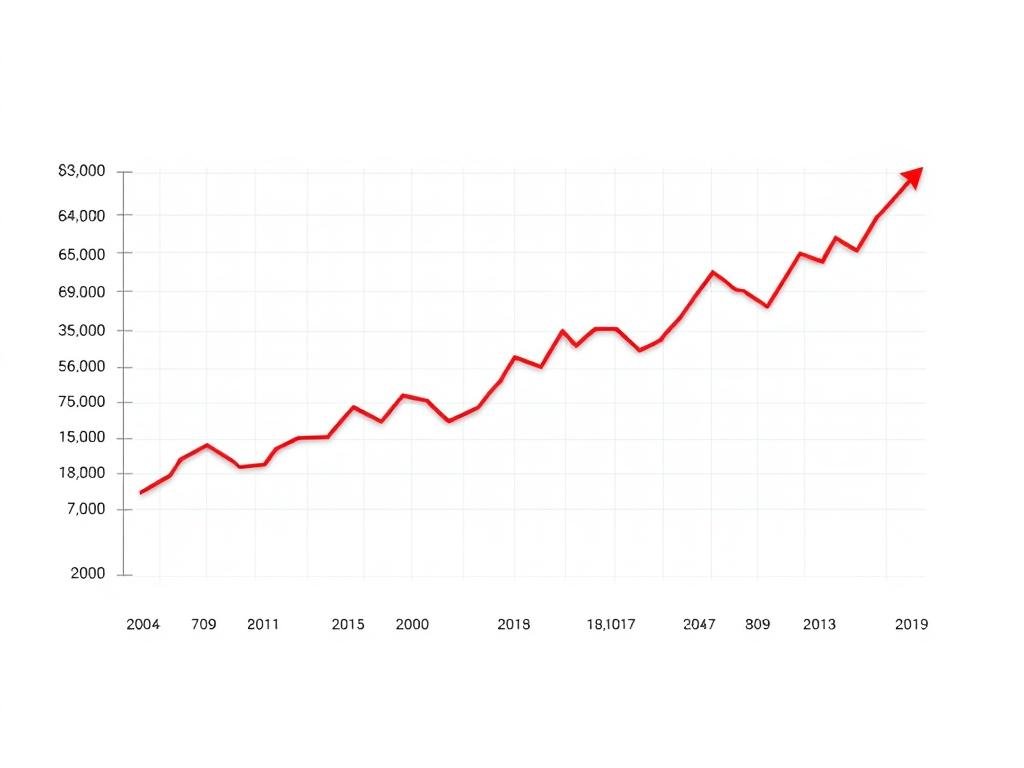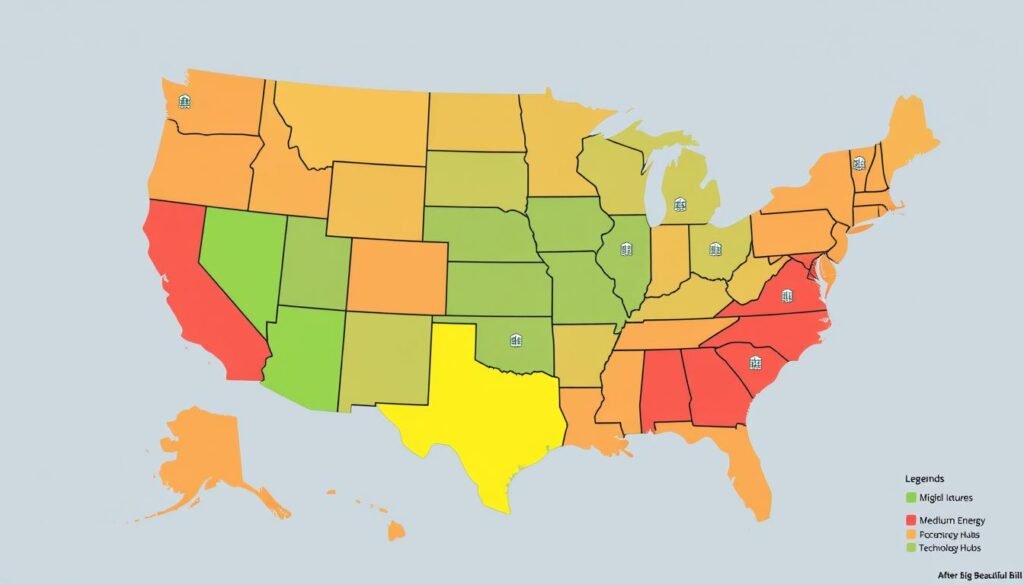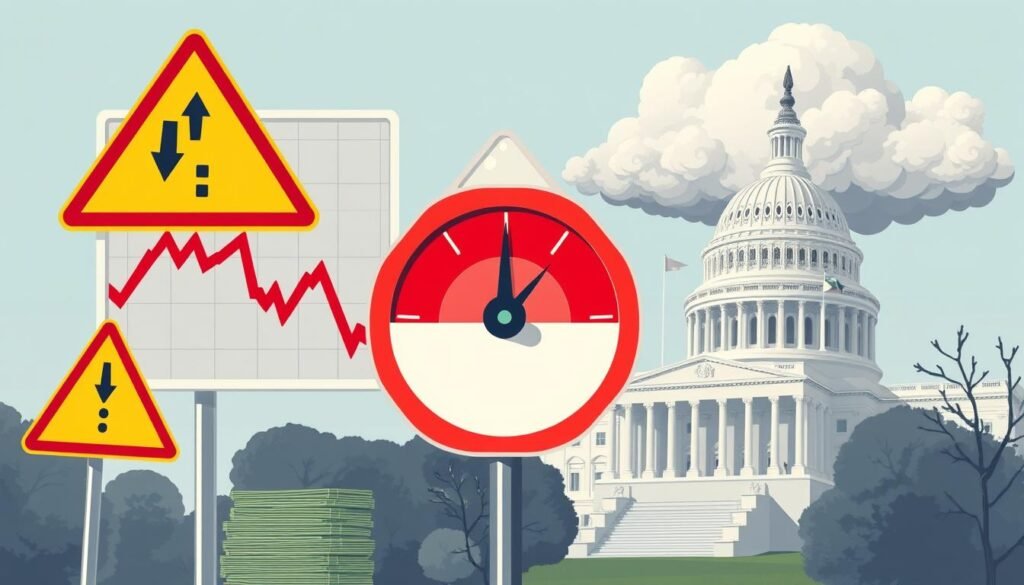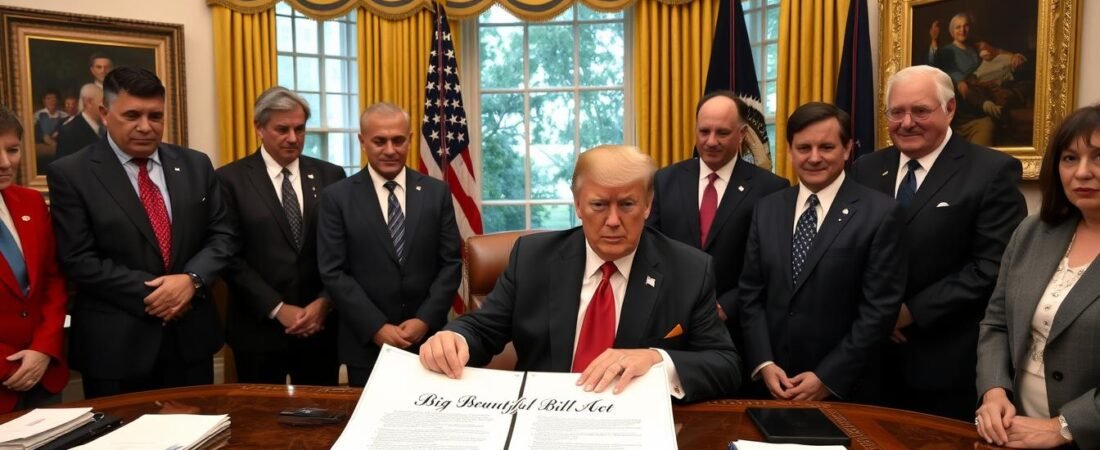The passage of President Trump’s “Big Beautiful Bill” marks a watershed moment for American economic policy with far-reaching implications for investors. This comprehensive legislation—combining tax cuts, regulatory changes, and targeted spending—will reshape investment landscapes across sectors for years to come. Understanding Trump’s Big Beautiful Bill investment impact is crucial for positioning your portfolio to capitalize on emerging opportunities while mitigating potential risks in this new economic environment.
As markets digest these sweeping changes, investors face critical questions: Which sectors will thrive? How will different asset classes perform? What strategies will yield the best returns in this transformed landscape? This analysis explores the decade ahead through multiple lenses, offering insights for both retail and institutional investors navigating the post-BBB world.
Understanding Trump’s Big Beautiful Bill: Key Provisions Affecting Investors
President Trump signs the landmark “Big Beautiful Bill” legislation that will reshape America’s economic landscape
The One Big Beautiful Bill Act represents one of the most significant economic policy shifts in decades. At its core, the legislation makes permanent the tax cuts from Trump’s first term while introducing new provisions that will fundamentally alter investment calculations across the economy.
Jay Timmons, President of the National Association of Manufacturers, called the bill “huge” for American business, noting that “this is really the first time that I have seen in my lifetime that we have actually gotten it right on the growth side of the equation.” This enthusiasm from the business community signals potential opportunities for investors in manufacturing and related sectors.
Key provisions with direct investment implications include:
- Permanent extension of the 2017 tax cuts, providing certainty for business planning
- New deductions for manufacturing investments, particularly for domestic production
- Significant cuts to Medicaid and other safety net programs, affecting healthcare sector dynamics
- Accelerated phaseout of clean energy tax credits, reshaping the energy investment landscape
- Substantial border wall and immigration enforcement funding, boosting certain defense and security contractors
The Congressional Budget Office estimates the bill will add approximately $3 trillion to the national debt over the next decade, creating potential macroeconomic headwinds that investors must factor into long-term strategies.
Economic Growth vs. Deficit Concerns: The Macroeconomic Backdrop

Projected economic growth vs. deficit trends over the next decade following the bill’s implementation
The bill creates a complex macroeconomic environment characterized by competing forces. On one hand, tax cuts and business incentives are designed to stimulate growth. On the other, rising deficits may create long-term pressures on interest rates and inflation.
Former Treasury Secretary Larry Summers expressed concern about the bill’s fiscal impact: “This represents one of the largest peacetime deficit increases in American history. While the growth effects are real, the magnitude of the debt increase creates significant macroeconomic risks over the medium term.”
For investors, this tension between growth and deficit concerns creates a challenging environment requiring careful portfolio positioning:
Growth Opportunities
- Corporate earnings boost from tax cuts
- Increased business investment in manufacturing
- Reduced regulatory compliance costs
- Higher consumer spending from tax savings
Deficit Challenges
- Potential interest rate pressures
- Long-term inflation risks
- Reduced fiscal flexibility for future crises
- Possible currency valuation effects
The bill’s impact on economic growth is expected to follow a distinct pattern: an initial surge in the first 2-3 years as tax cuts stimulate spending, followed by a moderation as deficit effects begin to create headwinds. This suggests a potential “investment window” for growth-oriented strategies before transitioning to more defensive positioning.
Stay Ahead of Economic Shifts
Get our quarterly Economic Impact Briefing to track how Trump’s Big Beautiful Bill investment impact evolves over time. Our team of economists provides data-driven insights to help you adjust your investment strategy as conditions change.
Asset Class Performance Outlook: Where to Invest in the Post-BBB Decade

Different asset classes will respond uniquely to the economic environment created by the bill
Equities: Sector Rotation and New Leaders
The equity markets are poised for significant sector rotation as the bill’s provisions create new winners and losers. Traditional value sectors like manufacturing, energy, and defense appear positioned for outperformance, while sectors dependent on government spending or clean energy incentives face headwinds.
Small-cap stocks may see particular benefit from the bill’s provisions, as they typically have higher effective tax rates than large multinationals and thus benefit more from tax cuts. Additionally, companies with primarily domestic operations stand to gain more than those with significant international exposure.
Fixed Income: Navigating Rising Yields
The bond market faces complex crosscurrents from the bill. The substantial increase in government borrowing is likely to put upward pressure on yields, particularly in the intermediate and long-term segments of the curve. This creates challenges for traditional bond portfolios but opportunities in floating-rate instruments and inflation-protected securities.
Municipal bonds may see increased demand as the bill’s SALT deduction changes affect high-tax states. Corporate bonds from sectors benefiting from the bill’s provisions may outperform the broader market.
Alternative Assets: New Opportunities Emerge
Real estate investments face a mixed outlook, with commercial properties in manufacturing zones potentially benefiting while residential markets adjust to interest rate pressures. Infrastructure investments aligned with domestic manufacturing expansion offer compelling opportunities.
Cryptocurrency markets may benefit from regulatory clarity that emerges in the wake of the bill, though they remain subject to their own unique drivers beyond policy impacts.
| Asset Class | Short-Term Outlook (1-2 Years) | Medium-Term Outlook (3-5 Years) | Long-Term Outlook (6-10 Years) |
| US Large-Cap Equities | Strongly Positive | Moderately Positive | Neutral |
| US Small-Cap Equities | Strongly Positive | Positive | Moderately Positive |
| US Treasury Bonds | Negative | Neutral | Moderately Positive |
| Corporate Bonds | Neutral | Moderately Positive | Positive |
| Real Estate | Mixed | Positive (Industrial) | Sector-Dependent |
| Commodities | Positive (Industrial) | Moderately Positive | Neutral |
Sector-by-Sector Investment Outlook: Winners and Losers

Manufacturing sectors are expected to see significant benefits from the bill’s provisions
Manufacturing: The Clear Winner
Manufacturing stands out as perhaps the clearest beneficiary of the bill’s provisions. The combination of tax incentives, immediate expensing for new facilities, and reduced regulatory burdens creates a powerful tailwind for domestic production.
“The certainty that this bill provides, especially for small manufacturers, those folks that are part of the supply chain, that is really critical,” notes Jay Timmons of the National Association of Manufacturers. This certainty translates to increased capital expenditure and potential earnings growth for manufacturing companies.
Investment opportunities include industrial equipment makers, factory automation providers, and companies throughout the manufacturing supply chain. Reshoring initiatives may accelerate, benefiting industrial real estate and logistics providers as well.
Energy: Fossil Fuels Resurgent, Renewables Face Headwinds
The energy sector faces a dramatic shift as the bill accelerates the phaseout of clean energy tax credits while removing regulatory barriers for traditional energy production. This creates a bifurcated outlook within the sector.
Traditional energy companies, particularly those focused on domestic production, stand to benefit significantly. Conversely, pure-play renewable energy companies face challenges as incentives diminish, though those with diversified business models may weather the transition better.
The bill’s impact on Tesla and other electric vehicle manufacturers has been particularly controversial, with Elon Musk criticizing the abrupt end to EV tax credits as “severely damaging industries of the future.” This policy shift creates potential value opportunities in the EV supply chain for investors with longer time horizons.
Healthcare: Adapting to Safety Net Changes
Healthcare faces complex crosscurrents from the bill’s provisions, particularly the substantial changes to Medicaid. Hospital systems with high exposure to Medicaid patients may face revenue pressures, while private insurers could see expanded opportunities as states adjust their healthcare approaches.
Pharmaceutical and medical device companies benefit from the continuation of business-friendly tax policies, though they must navigate a changing reimbursement landscape. Companies offering cost-effective solutions that reduce overall system expenses may find particular favor in this environment.
Technology: Mixed Outlook with New Challenges
The technology sector presents a nuanced investment landscape under the bill. Large tech companies benefit from permanent tax cuts but face potential headwinds from reduced government spending in certain areas and possible regulatory changes.
Semiconductor manufacturers receive specific incentives in the bill, creating opportunities in this critical subsector. Software and services companies that help businesses optimize operations in the new tax environment may also outperform.
Defense and Border Security: Budget Windfalls
With substantial allocations for border security and military spending, companies in these sectors stand to benefit directly from increased government contracts. The bill allocates approximately $46.5 billion for border wall construction and $45 billion for immigration enforcement, creating significant revenue opportunities for contractors in these spaces.
Defense companies focused on Trump’s “Golden Dome” missile defense initiative and other military priorities will see expanded contract opportunities, potentially driving earnings growth over multiple years.
Sector-Specific Investment Strategies
Download our detailed sector analysis report to discover specific companies positioned to benefit from Trump’s Big Beautiful Bill investment impact. Our research team has identified key opportunities in manufacturing, energy, healthcare, and defense sectors.
Tax Planning Strategies for the New Environment

Strategic tax planning becomes increasingly important in the post-BBB investment landscape
The bill’s tax provisions create significant planning opportunities for investors. The permanence of the 2017 tax cuts removes uncertainty that had complicated long-term planning, while new deductions offer additional strategies to optimize after-tax returns.
Key tax planning considerations include:
- Maximizing benefits from the expanded SALT deduction cap ($40,000 vs. previous $10,000)
- Leveraging new deductions for tip income (up to $25,000) and overtime income (up to $12,500)
- Optimizing business structure to benefit from permanent pass-through deductions
- Utilizing the expanded estate tax exemption for wealth transfer planning
- Exploring opportunities with the new “Trump accounts” for children’s savings
For business owners and investors in pass-through entities, the bill’s provisions are particularly significant. The permanent extension of the 20% qualified business income deduction creates substantial tax savings that can be reinvested for growth or distributed to owners.
Investors should also consider the bill’s impact on municipal bonds, particularly in high-tax states where the expanded SALT deduction may alter the relative attractiveness of tax-exempt income.
Regional Investment Opportunities: State-by-State Analysis

The bill’s impact varies significantly by region, creating geographically diverse investment opportunities
The bill’s provisions will affect states differently based on their economic composition, tax structures, and reliance on federal programs. This creates geographically diverse investment opportunities that savvy investors can leverage.
Manufacturing Belt Resurgence
States with strong manufacturing bases—particularly in the Midwest and Southeast—stand to benefit disproportionately from the bill’s manufacturing incentives. Ohio, Michigan, Indiana, Tennessee, and South Carolina may see accelerated economic activity as companies expand production facilities.
Real estate investors should consider industrial properties in these regions, while municipal bond investors may find improving credit fundamentals as economic activity increases.
Energy State Dynamics
Traditional energy-producing states like Texas, Oklahoma, North Dakota, and Wyoming benefit from the bill’s fossil fuel-friendly provisions. Conversely, states that had positioned themselves as clean energy hubs, such as California and New York, face adaptation challenges.
This creates potential opportunities in energy infrastructure, particularly in traditional energy corridors, while also potentially affecting municipal finances in states heavily invested in renewable energy transitions.
Border States and Security Spending
States along the southern border will see significant federal spending for wall construction and immigration enforcement. This creates economic activity that may benefit local businesses, real estate markets, and municipal finances in these regions.
Texas, Arizona, New Mexico, and California will see direct impacts from the approximately $90 billion allocated for border security measures, creating investment opportunities in construction, services, and infrastructure companies operating in these states.
High-Tax State Adjustments
The bill’s expansion of the SALT deduction cap to $40,000 provides significant relief for high-income residents of high-tax states like California, New York, New Jersey, and Illinois. This may stabilize high-end real estate markets in these states and reduce outmigration pressures.
However, these states also face challenges from the bill’s Medicaid changes, as they typically have more generous programs that will require state funding adjustments. This creates a complex fiscal picture that investors must navigate carefully.
Low-Tax State Competitiveness
States with low tax burdens may see their competitive advantage somewhat diminished by the expanded SALT deduction cap. However, they generally benefit from the bill’s business-friendly provisions and may continue to attract corporate relocations.
Florida, Texas, Tennessee, and other low-tax states remain well-positioned for growth, particularly as the bill’s manufacturing incentives align with their generally business-friendly regulatory environments.
Strategic Investment Approaches for the Next Decade
The complex investment environment created by Trump’s Big Beautiful Bill requires thoughtful strategic approaches. Investors should consider these key strategies for navigating the decade ahead:
Phased Approach to Sector Rotation
Rather than making dramatic portfolio shifts immediately, investors should consider a phased approach to sector rotation that aligns with the bill’s implementation timeline. Initial emphasis on direct beneficiaries (manufacturing, traditional energy, defense) can gradually evolve as market dynamics develop.
This approach allows investors to capture early opportunities while maintaining flexibility to adjust as second-order effects emerge and market valuations evolve.
Tax-Aware Investment Management
The bill’s tax provisions create opportunities for tax-aware investment management that can significantly enhance after-tax returns. Strategies include:
- Asset location optimization across taxable and tax-advantaged accounts
- Tax-loss harvesting to offset gains in sectors benefiting from the bill
- Consideration of municipal bonds for high-income investors in high-tax states
- Utilization of the expanded estate tax exemption for intergenerational wealth planning
Inflation and Interest Rate Hedging
The bill’s deficit implications create potential inflation and interest rate risks that prudent investors should hedge against. Strategies include:
- Allocation to Treasury Inflation-Protected Securities (TIPS) and floating-rate instruments
- Consideration of commodities and real assets as inflation hedges
- Emphasis on companies with pricing power and low debt levels
- Careful duration management in fixed income portfolios
Private Market Opportunities
The bill creates significant opportunities in private markets, particularly in areas aligned with its key provisions. Private equity investments in manufacturing, energy infrastructure, and defense technology may offer compelling returns as these sectors adapt to the new policy environment.
For accredited investors, private debt opportunities may also emerge as companies restructure to optimize their positions under the new tax regime.
Personalized Investment Strategy
Receive a customized investment roadmap tailored to your financial goals in the post-BBB environment. Our team of financial advisors will analyze your current portfolio and recommend strategic adjustments to capitalize on emerging opportunities.
Historical Context: Comparing Trump’s Bill to Past Economic Legislation
To better understand the potential investment implications of Trump’s Big Beautiful Bill, it’s valuable to examine how markets responded to previous significant economic legislation.
Reagan Tax Cuts (1981-1986)
The Reagan tax cuts, particularly the Economic Recovery Tax Act of 1981 and the Tax Reform Act of 1986, created a prolonged bull market in equities. However, they also contributed to significant deficit increases and eventually led to tax increases under subsequent administrations.
Key lesson: Initial market enthusiasm can create strong investment returns, but fiscal imbalances eventually require correction, creating later headwinds.
Bush Tax Cuts (2001-2003)
The Bush tax cuts were implemented during challenging economic conditions following the dot-com crash and 9/11. While they provided economic stimulus, their investment impact was initially muted by these external factors before contributing to the mid-2000s bull market.
Key lesson: External economic conditions can delay or diminish the market impact of tax-focused legislation.
Obama’s Affordable Care Act (2010)
The ACA created significant sector-specific impacts, particularly in healthcare. Hospital stocks initially benefited from expanded coverage, while insurers faced adaptation challenges. The legislation demonstrated how sector-specific provisions can create investment opportunities and risks regardless of the broader economic impact.
Key lesson: Sector-specific provisions require targeted investment approaches rather than broad market bets.
Biden’s Inflation Reduction Act (2022)
The IRA’s clean energy provisions created significant investment opportunities in renewable energy, electric vehicles, and related sectors. The targeted nature of the bill’s incentives demonstrated how policy can reshape sector economics and create new investment themes.
Key lesson: Policy shifts can create entirely new investment categories and dramatically alter sector economics.
Trump’s Big Beautiful Bill combines elements of these previous legislative efforts—tax cuts similar to Reagan/Bush, sector-specific impacts like the ACA, and targeted incentives like the IRA. This suggests investors should prepare for both broad market impacts and specific sector opportunities.
Risks and Challenges: What Could Derail the Investment Outlook

Several key risks could significantly alter the investment landscape created by the bill
While the bill creates numerous investment opportunities, prudent investors must also consider potential risks that could derail the expected outcomes. Key challenges include:
Deficit and Debt Market Reactions
The CBO estimates the bill will add approximately $3 trillion to the national debt over the next decade. If bond markets react negatively to this fiscal expansion, interest rates could rise more rapidly than anticipated, creating headwinds for both equity and fixed income investments.
Former Treasury Secretary Larry Summers has warned that “the magnitude of the debt increase creates significant macroeconomic risks over the medium term.” Investors should monitor bond market reactions closely as an early indicator of potential challenges.
Inflation Resurgence
The combination of fiscal stimulus, reduced immigration, and potential supply chain disruptions could reignite inflation pressures. This would likely prompt more aggressive monetary policy responses, potentially creating challenging conditions for both stocks and bonds.
Sectors with limited pricing power or high debt loads would be particularly vulnerable to an inflation resurgence scenario.
International Trade Tensions
The bill’s domestic manufacturing focus could exacerbate international trade tensions, particularly if trading partners view certain provisions as protectionist. Resulting tariffs or trade restrictions could disrupt global supply chains and create challenges for companies with significant international operations.
Investors should monitor diplomatic developments and trade negotiations as indicators of potential disruptions.
Policy Implementation Challenges
The bill’s ambitious provisions face implementation challenges that could delay or diminish their expected impacts. Administrative capacity constraints, legal challenges, and practical execution difficulties could all affect the timing and magnitude of the bill’s economic effects.
This creates potential disconnects between market expectations and economic reality that investors must navigate carefully.
Political Sustainability
The partisan nature of the bill’s passage raises questions about its long-term political sustainability. Future administrations or congressional majorities could seek to modify or reverse certain provisions, creating policy uncertainty that markets typically discount negatively.
Investors should consider the potential for policy reversals when making long-term investment decisions, particularly in areas most directly affected by the bill’s provisions.
Frequently Asked Questions About Investing After the Big Beautiful Bill

Investors have many questions about navigating the post-BBB investment landscape
How does Trump’s Big Beautiful Bill compare to Biden’s Inflation Reduction Act for investors?
The two bills represent fundamentally different approaches to economic policy. Biden’s IRA focused on clean energy incentives, healthcare cost controls, and targeted tax increases on corporations. Trump’s BBB makes permanent the 2017 tax cuts, incentivizes traditional manufacturing and energy production, and reduces social program spending.
For investors, this means a significant shift in sector opportunities. The IRA created tailwinds for renewable energy, electric vehicles, and healthcare cost containment solutions. The BBB creates opportunities in traditional manufacturing, fossil fuels, defense, and border security, while potentially creating headwinds for clean energy investments that benefited from the IRA.
Will the bill’s deficit impact eventually hurt stock market returns?
Historical evidence suggests that deficit impacts on markets typically follow a delayed pattern. In the near term (1-3 years), the growth stimulus from tax cuts often outweighs deficit concerns, supporting equity valuations. However, as debt accumulates and potentially pressures interest rates higher, markets may begin to price in these fiscal challenges.
Prudent investors should consider a phased approach that captures near-term growth opportunities while gradually increasing allocation to investments that can weather potential later-stage deficit impacts, such as companies with strong balance sheets and limited interest rate sensitivity.
How should retirement investors adjust their portfolios in response to the bill?
Retirement investors should consider several adjustments to their portfolios:
- Review sector allocations to ensure appropriate exposure to manufacturing, energy, and defense sectors that benefit from the bill
- Consider the bill’s inflation implications for retirement income planning
- Evaluate tax-advantaged account strategies in light of the permanent tax cuts
- Assess bond duration and inflation protection components given potential interest rate pressures
- For those near retirement, consider the bill’s impact on healthcare costs and planning
The appropriate adjustments will vary based on time horizon, risk tolerance, and specific retirement goals.
Which small-cap sectors offer the best opportunities under the bill?
Small-cap companies often benefit disproportionately from domestic-focused economic policies, as they typically have higher effective tax rates and more concentrated U.S. operations than large multinationals. Under the BBB, particularly promising small-cap sectors include:
- Regional manufacturing suppliers and industrial equipment providers
- Domestic energy producers and service companies
- Specialized defense and border security contractors
- Regional banks that finance manufacturing expansion
- Healthcare providers adapting to the changing Medicaid landscape
Small-cap value stocks may outperform small-cap growth in this environment, reversing a trend seen during periods of loose monetary policy.
How will the bill affect real estate investments across different regions?
Real estate impacts will vary significantly by property type and region:
- Industrial properties in manufacturing-heavy states (Midwest, Southeast) should benefit from expansion
- Residential real estate in high-tax states may stabilize due to the expanded SALT deduction cap
- Commercial properties in border regions could see increased demand from security spending
- Office properties face mixed impacts depending on regional economic effects
- All property types must navigate potential interest rate pressures from deficit impacts
REITs focused on industrial properties in manufacturing corridors offer particularly interesting opportunities, while those concentrated in states facing Medicaid funding challenges may encounter headwinds.
Conclusion: Positioning Your Portfolio for the Decade Ahead

Strategic portfolio positioning will be essential for navigating the investment landscape shaped by the bill
Trump’s Big Beautiful Bill represents a significant inflection point for the American economy and investment landscape. The legislation’s combination of tax cuts, regulatory changes, and spending priorities will reshape sector dynamics and create both opportunities and challenges for investors over the coming decade.
Successful navigation of this environment requires a nuanced approach that balances capturing near-term growth opportunities with prudent risk management for potential longer-term challenges. Sector selection, tax-aware investing, and thoughtful asset allocation will be particularly important in this environment.
As you position your portfolio for the decade ahead, consider not just the direct impacts of the bill’s provisions, but also second-order effects and potential policy evolutions. The most successful investors will be those who can adapt their strategies as the bill’s impacts unfold and interact with broader economic and market forces.
What investment adjustments will you make to position your portfolio for success in this new landscape?
Stay Informed on Market Developments
Subscribe to our Investment Impact Newsletter for ongoing analysis of how Trump’s Big Beautiful Bill investment impact continues to reshape markets. Receive quarterly updates, sector spotlights, and strategic recommendations from our research team.
